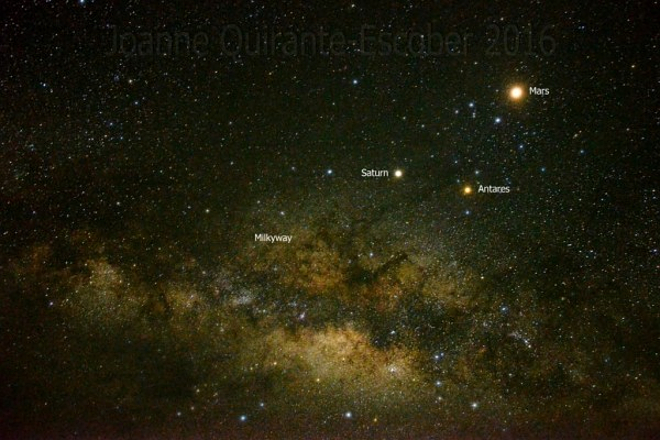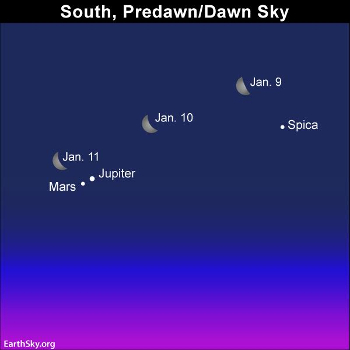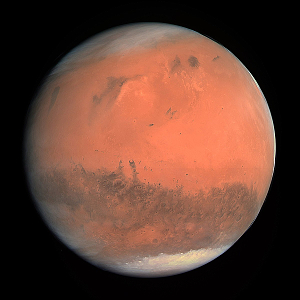 |
| Joanne Richard Escober caught this image of Mars, Saturn and Antares on May 28, 2016 – around the time of Mars’ last opposition – at Apo Reef Natural Park Occidental Mindoro, Philippines. Mars was very bright in 2016, but it’ll be even brighter in 2018! |
EarthSky.org
 |
| Fresh from their magnificent conjunction on January 7, Jupiter and Mars will appear near the moon on January 9-12. |
Mars can be a bright planet. It can outshine most stars. But, in 2003, for a few months, Mars was exceedingly spectacular in our sky, outshining all the stars and planets except brilliant Venus. In 2018, Mars won’t be quite as bright as it was in 2003.
But nearly!
It’ll dramatically brighten over the coming months to appear as a red dot of brilliant flame in our sky around July, 2018.
More than any other bright planet, the appearance of Mars in our night sky changes from year to year. Its dramatic swings in brightness are part of what make Mars a fascinating planet to watch with the eye alone.
Mars was faint throughout 2017. But it’s a bit brighter now, as you might have noticed on Sunday, January 7, when Mars and Jupiter had their stunning conjunction before dawn.
When you contrast the brightness of Mars and Jupiter in January 2018, you might not believe that Mars will be brighter than Jupiter in six months. But it’s true.
In late July 2018, around the time Earth sweeps between Mars and the sun, Mars will outshine Jupiter by some 1.8 times.
Why does Mars sometimes appear very bright, and sometimes very faint? The first thing to realize is that Mars isn’t a very big world. It is only 4,219 miles (6,790 km), making it only slightly more than half as big as Earth at 7,922 miles (12,750 km) in diameter.
So, when it’s bright, its brightness isn’t due to its bigness, as is the case with Jupiter.
 |
Sometimes Earth and Mars are on the same side of the solar system, and hence near one another. At other times, as it was throughout most of 2017, Mars is far across the solar system from us.
Mars orbits the sun just one step outward from Earth’s orbit. Earth takes a year to orbit the sun once. Mars takes about two years to orbit once. Opposition for Mars, when Earth passes between Mars and the sun, happens every two years and 50 days.
So Mars’ brightness waxes and wanes in our sky about every two years. But 2018 is a very, very special year for Mars. Mars will appear brighter in our sky this year than it has since 2003.
The last opposition was on May 22, 2016. Around that time, Mars was very bright indeed in Earth’s sky.
This 2018 opposition of Mars isn’t an ordinary opposition. Astronomers will call it a perihelic opposition (or perihelic apparition) of Mars.
The word perihelion refers the point in Mars’ orbit when it is closest to the sun. Maybe you can see that – in years when we pass between Mars and the sun, when Mars is also closest to the sun – Earth and Mars are closest.
That’s what will be happening in 2018, and it’s why the Association of Lunar and Planetary Observers (ALPO) wrote, "The 2018 perihelic apparition of Mars will prove to be one of the most favorable since the 2003 apparition when the Red Planet came closest to Earth in 59,635 years ... the year 57,617 BC."
According to ALPO, in 2003, Mars came within 34.6 million miles to Earth, closer than at any time in over nearly 60,000 years! It’ll be only 1.2 million miles farther away in 2018. Closest approach for Mars in 2018 will take place on July 31, some four days after its July 27 opposition.
For a period of about two months, Mars will supplant Jupiter as the fourth brightest celestial body, after the sun, moon and Venus. Mars’ reign as the fourth-brightest celestial body (or third brightest in the nighttime sky, after the moon and Venus) will last from about July 7 to September 7.
So 2017 was, indeed, a lousy year for Mars. But just wait! Mars will be grand in 2018.